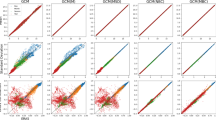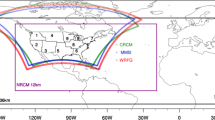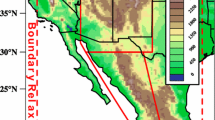Abstract
Regional climate models (RCM) are an important tool for simulating atmospheric information at finer resolutions often of greater relevance to local scale climate change impact assessment studies. The lateral and lower boundary conditions, which form the inputs to the RCM downscaling application, are outputs from the global climate model (GCM). These boundary variables are known to be biased in GCMs, providing the potential to use a statistical approach that corrects these biases before use in downscaling. An array of bias correction techniques have been developed to remove these biases before being used to drive the RCM, but questions remain on their efficacy in terms of the final downscaled output. This study assesses the impact of these bias correction strategies by focussing on how these corrections are translated as one proceeds from the lateral boundaries into the model interior. Of specific interest is the change in the correction from generation of the lateral boundary conditions as well as how correction information moves through the relaxation zone and into the interior of the model. Here we show that bias correction information passing into the regional climate model is limited by interpolations required to generate lateral boundary conditions and dominant outflow wind conditions in the boundaries. This work suggests that these limitations should be addressed in order for bias correction of lateral boundary conditions to robustly influence RCM simulations of climate in the interior of the model domain.






Similar content being viewed by others
References
Bruyère CL, Done JM, Holland GJ, Fredrick S (2014) Bias corrections of global models for regional climate simulations of high-impact weather. Clim Dyn 43(7–8):1847–1856
Davies HC, Turner RE (1977) Updating prediction models by dynamical relaxation: an examination of the technique. Q J R Meteorol Soc 103(436):225–245
Dee DP et al (2011) The ERA-interim reanalysis: configuration and performance of the data assimilation system. Q J R Meteorol Soc 137(656):553–597
Di Virgilio G et al (2019) Evaluating reanalysis-driven CORDEX regional climate models over Australia: model performance and errors. Clim Dyn. https://doi.org/10.1007/s00382-019-04672-w
Errico RM, VukiĆEviĆ T, Raeder K (1993) Comparison of initial and lateral boundary condition sensitivity for a limited-area model. Tellus A 45(5):539–557
Evans JP, McCabe MF (2013) Effect of model resolution on a regional climate model simulation over southeast Australia. Clim Res 56(2):131–145
Evans JP, Ekström M, Ji F (2012) Evaluating the performance of a WRF physics ensemble over South-East Australia. Clim Dyn 39(6):1241–1258
Giorgi F, Bi X (2000) A study of internal variability of a regional climate model. J Geophys Res Atmos 105(D24):29503–29521
Johnson F, Sharma A (2011) Accounting for interannual variability: a comparison of options for water resources climate change impact assessments. Water Resour Res 47(4):1–20
Maraun D (2016) Bias correcting climate change simulations—a critical review. Curr Clim Change Rep 2:211–220
Marbaix P, Gallée H, Brasseur O, Ypersele J-PV (2003) Lateral boundary conditions in regional climate models: a detailed study of the relaxation procedure. Mon Weather Rev 131(3):461–479
Meehl GA, Covey C, Taylor KE, Delworth T, Stouffer RJ, Latif M, McAvaney B, Mitchell JFB (2007) The WCRP CMIP3 multimodel dataset: a new era in climate change research. Bull Am Meteorol Soc 88(9):1383–1394
Moalafhi DB, Sharma A, Evans JP, Mehrotra R, Rocheta E (2017) Impact of bias-corrected reanalysis-derived lateral boundary conditions on WRF simulations. J Adv Model Earth Syst 9(4):1828–1846
Olson R, Evans JP, Di Luca A, Argueso D (2016) The NARCliM project: model agreement and significance of climate projections. Clim Res 69:209–227
Rocheta E, Evans JP, Sharma A (2014a) Assessing atmospheric bias correction for dynamical consistency using potential vorticity. Environ Res Lett 9(12):124010
Rocheta E, Sugiyanto M, Johnson F, Evans J, Sharma A (2014b) How well do general circulation models represent low-frequency rainfall variability? Water Resour Res 50:2108–2123. https://doi.org/10.1002/2012WR013085
Rocheta E, Evans JP, Sharma A (2017) Can bias correction of regional climate model lateral boundary conditions improve low-frequency rainfall variability? J Clim 30:9785–9806
Seth A, Giorgi F (1998) The effects of domain choice on summer precipitation simulation and sensitivity in a regional climate model. J Clim 11(10):2698–2712
Skamarock WC, Klemp JB, Dudhia J, Gill DO, Barker DM, Duda MG, Huang XY, Wang W, Powers JG (2008) A description of the advanced research WRF Version 3
Vukicevic T, Errico RM (1990) The influence of artificial and physical factors upon predictability estimates using a complex limited-area model. Mon Weather Rev 118(7):1460–1482
Warner TT, Peterson RA, Treadon RE (1997) A tutorial on lateral boundary conditions as a basic and potentially serious limitation to regional numerical weather prediction. Bull Am Meteorol Soc 78(11):2599–2617
White RH, Toumi R (2013) The limitations of bias correcting regional climate model inputs. Geophys Res Lett 40(12):2907–2912
Wu W, Lynch AH, Rivers A (2005) Estimating the uncertainty in a regional climate model related to initial and lateral boundary conditions. J Clim 18(7):917–933
Xu Z, Yang ZL (2012) An improved dynamical downscaling method with GCM bias corrections and its validation with 30 years of climate simulations. J Clim 25:6271–6286
Acknowledgements
Funding for this research came from the Australian Research Council (FT110100576 and FT100100197) and the Peter Cullen Postgraduate Scholarship. This research was undertaken with the assistance of resources provided at the NCI National Facility systems at the Australian National University through the National Computational Merit Allocation Scheme supported by the Australian Government. We acknowledge the modeling groups for making their model output available for analysis, the PCMDI for collecting and archiving, and the WGCM for organizing this data. ERA-Interim data was obtained from the European Centre for Medium-Range Weather Forecasts (ECMWF) online archive catalogue. Thanks also to the anonymous reviewers who shared their expertise and provided useful commentary which improved the quality of this paper.
Author information
Authors and Affiliations
Corresponding author
Additional information
Publisher's Note
Springer Nature remains neutral with regard to jurisdictional claims in published maps and institutional affiliations.
Rights and permissions
About this article
Cite this article
Rocheta, E., Evans, J.P. & Sharma, A. Correcting lateral boundary biases in regional climate modelling: the effect of the relaxation zone. Clim Dyn 55, 2511–2521 (2020). https://doi.org/10.1007/s00382-020-05393-1
Received:
Accepted:
Published:
Issue Date:
DOI: https://doi.org/10.1007/s00382-020-05393-1




